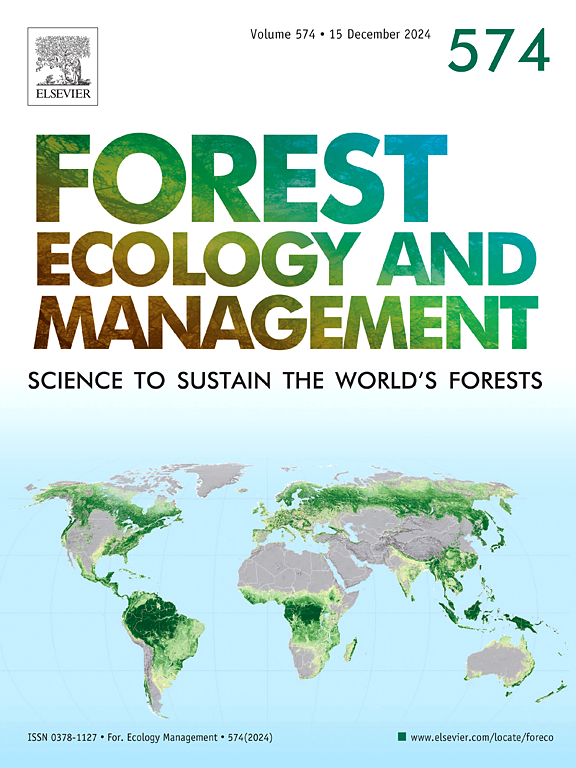美国太平洋西北地区造林过程中树木间距对三种重要树种生存和生长的长期影响
IF 3.7
2区 农林科学
Q1 FORESTRY
引用次数: 0
摘要
造林过程中的树木间距是影响林分发展轨迹和速率的关键决策,但在有意义的时间尺度上对响应的量化有限,无法用于管理。在这里,我们报告了美国华盛顿西部瀑布的海岸道格拉斯冷杉(DF, pseudosuga menziesii var. menziesii)、冷杉(NF, Abies procera)和西部白松(WWP, Pinus monticola)对5或6个间距为1至6 m的处理的响应。在0.4 ha的完全随机设计中,每个处理4-6个重复,分别测试了每个物种的间距效应。在WWP和NF中,间距对相对存活率没有影响;对于DF,相对存活率随间距的减小而降低,且随时间的延长而更加明显。二次平均直径随水位差和水位差的增大而增大,但在水位差大于4 m时,影响减弱。在大部分研究期间,所有树种的林分总积与林分间距呈负相关,但在最近的测量中,不同林分间距的林分积没有差异,这是因为当林分密度指数增加到最大值的55% %以上时,狭窄林分间距的密度依赖性死亡率较高。研究结果表明,较宽的间距(5 - 6 m)促进了林分结构更复杂的树木的生长,而3 - 4 m的间距将最大限度地提高木材产量。在管理目标、造林资源限制和特定物种考虑的背景下讨论了这些发现的影响。本文章由计算机程序翻译,如有差异,请以英文原文为准。
Long-term effects of tree spacing during reforestation on survival and growth of three important tree species in the Pacific Northwest, USA
Tree spacing during reforestation is a critical decision that influences the trajectory and rate of stand development over time, but there is limited quantification of responses at meaningful time scales for management. Here we report on ∼40 year response of coast Douglas-fir (DF, Pseudotsuga menziesii var. menziesii), noble fir (NF, Abies procera) and western white pine (WWP, Pinus monticola) to five or six spacing treatments that ranged from 1 to 6 m in the western Cascades of Washington, USA. Spacing effects were tested separately for each species in completely randomized designs applied to 0.4 ha plots with 4–6 replications per treatment. There was no effect of spacing on relative survival in WWP and NF; for DF, relative survival decreased with decreasing spacing, with the effect becoming more pronounced with time. Quadratic mean diameter generally increased with increasing spacing for WWP and DF, but the effect attenuated at 4-m spacing and higher. Total stand volume was inversely related to spacing for all species for much of the study period, but there was no difference in volume among spacings for DF in the most recent measurement because of the density-dependent mortality in narrow spacings as Stand Density Index increased above 55 % of maximum. Our findings indicate that wider spacings (5–6-m) promote the development of larger trees with more complex stand structure (including that arising from ingrowth), while spacings of 3–4-m will maximize wood production. The implications of these findings are discussed in the context of management objectives, silvicultural resource constraints, and species-specific considerations.
求助全文
通过发布文献求助,成功后即可免费获取论文全文。
去求助
来源期刊

Forest Ecology and Management
农林科学-林学
CiteScore
7.50
自引率
10.80%
发文量
665
审稿时长
39 days
期刊介绍:
Forest Ecology and Management publishes scientific articles linking forest ecology with forest management, focusing on the application of biological, ecological and social knowledge to the management and conservation of plantations and natural forests. The scope of the journal includes all forest ecosystems of the world.
A peer-review process ensures the quality and international interest of the manuscripts accepted for publication. The journal encourages communication between scientists in disparate fields who share a common interest in ecology and forest management, bridging the gap between research workers and forest managers.
We encourage submission of papers that will have the strongest interest and value to the Journal''s international readership. Some key features of papers with strong interest include:
1. Clear connections between the ecology and management of forests;
2. Novel ideas or approaches to important challenges in forest ecology and management;
3. Studies that address a population of interest beyond the scale of single research sites, Three key points in the design of forest experiments, Forest Ecology and Management 255 (2008) 2022-2023);
4. Review Articles on timely, important topics. Authors are welcome to contact one of the editors to discuss the suitability of a potential review manuscript.
The Journal encourages proposals for special issues examining important areas of forest ecology and management. Potential guest editors should contact any of the Editors to begin discussions about topics, potential papers, and other details.
 求助内容:
求助内容: 应助结果提醒方式:
应助结果提醒方式:


